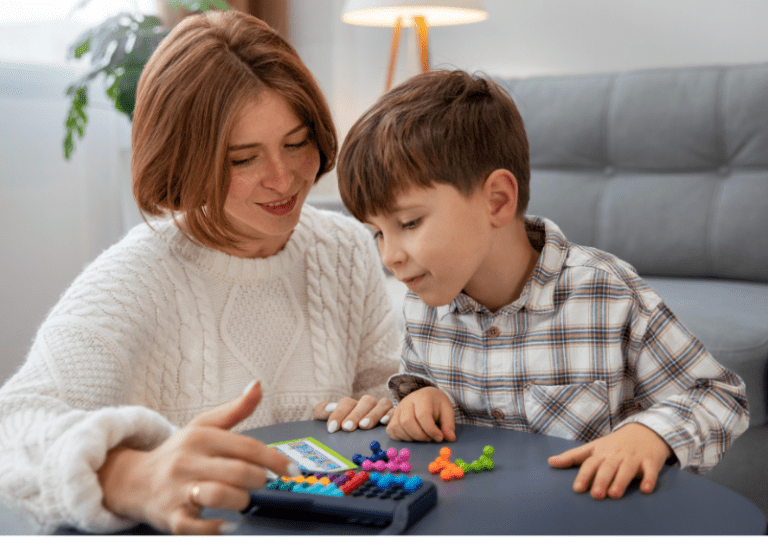Our previous blogs discussing the importance of Social and Emotional Learning (SEL) have laid a solid foundation for us to begin diving deeper into the core competencies of SEL. Today, we will dig into self-awareness and self-management. These competencies are the keys to unlocking a world of emotional intelligence and resilience for your child. So, let’s get down to the nitty-gritty!
As adults, we are aware that emotions have the ability to overtake us if we allow them to. These overpowering emotions can be even harder for our children to navigate. Our kiddos are still in the process of building their cognitive resources and learning the ups and downs of life. By teaching our children how to recognize, label, and identify the reasons behind their emotions, we are fostering the cultivation of self-awareness. This self-awareness, in turn, provides our children with the ability to decide how to react to the emotions they are feeling. The next step that occurs in this process is self-management. This is the moment that your child decides how they will handle that emotion. Will they shout for joy? Will they cry or throw a tantrum? Perhaps they decide to become defiant. The good news is that with loving and patient guidance, children can become excellent at both self-awareness and self-management. Let’s look at a few ways we can foster these SEL competencies in our kids.
Name Those Feelings!
A great place to begin is by encouraging your child to put a name to their feelings. Whether it’s joy, frustration, curiosity, or sadness, helping them find the right label for what they are feeling aids in their understanding of themselves. For instance, when your child seems overjoyed about an achievement or saddened due to a disagreement, this is your cue to acknowledge and discuss those emotions. The better they can understand themselves and how they respond to different situations and social interactions, the better equipped they will be to master other the competencies of SEL.
Make it Fun!
Self-awareness and self-management can also be taught to children through games and roleplay. Perhaps give a game of Emotional Charades a try! Write down different emotions on pieces of paper, put them in a hat, and take turns acting out the emotion without using words. This activity helps children recognize emotions in themselves and others while also practicing how to manage and express them. By engaging in this playful exercise, your child learns that emotions can be expressed in various ways and that it is okay to feel and express a wide range of emotions.
Help Them Find Their Zen!
Just like adults, children can become overstimulated, exhausted, and stressed. When a child is already sitting at a highly charged emotional baseline, recognizing and managing their emotions can become even more difficult than they would normally be. A great way to combat that baseline is by teaching your children calming and grounding techniques like deep breathing, counting to ten, or taking a short walk when things get overwhelming. Sometimes just stepping out into nature for a few minutes can shift a person’s emotional state. There are many routes to centering yourself and finding peace. Luckily, you are just the right person to help them identify their personal path to zen. By demonstrating these techniques yourself during stressful moments, you’re showcasing how to handle emotions constructively. These strategies help your children steer clear of emotional turbulence and prompt them to make thoughtful decisions from a calm and centered place.
Emotional Check-Ins!
Letting your child know that their feelings matter is vital to supporting the growth of their emotional intelligence. A great way to engage with your child is via the “emotional check-in.” Ask them how they’re feeling and encourage them to elaborate. Emotional check-ins are more than asking if they had a good day at school. They are about encouraging your child to elaborate as to why their day was good or bad and how they feel about it currently.
For younger children who may still struggle to identify their emotions, a support tool during emotional check-ins can be very effective. One recommendation is a visual emotion-wheel. These wheels show facial expressions and words that describe the moods. This simple mechanism can even be handmade at home and is a great way to help your little one open up!
Remember, no matter the age, it is always about listening without judgment and letting your child express themselves freely. Respecting your child’s autonomy is also important. They may not be ready to talk about things when prompted, and that’s okay. It’s during these times that you can express your support and care. This active interest in your child’s well-being and daily highs and lows helps to strengthen the bond between you and your child and allows room for further SEL competencies to develop.
Wrapping it up…
As we journey through the intricacies of nurturing self-awareness and self-management, remember that it’s a gradual process. Every time your child names an emotion, chooses calmness over rage, or opens up about their feelings, they’re building an essential life skill. So, if you see your child exhibiting self-awareness and self-management, let them know how proud you are! Tell them how impressive it is! Emotions are hard, and when our kiddos build the skills to manage them, that is a very big thing to celebrate. So, let’s keep practicing and celebrating these little victories together!
Stay tuned for more on SEL!
Sources & Resources for Parents:
CASEL – Core Competencies of SEL
Mindful Schools – Teaching Kids About Emotions
Positive Discipline – Emotional Regulation Strategies for Kids
Raising Children Network – Helping Children Express Emotions
The Imagination Tree – Emotional Development Through Journaling
Education World – Emotional Intelligence Activities for Kids


